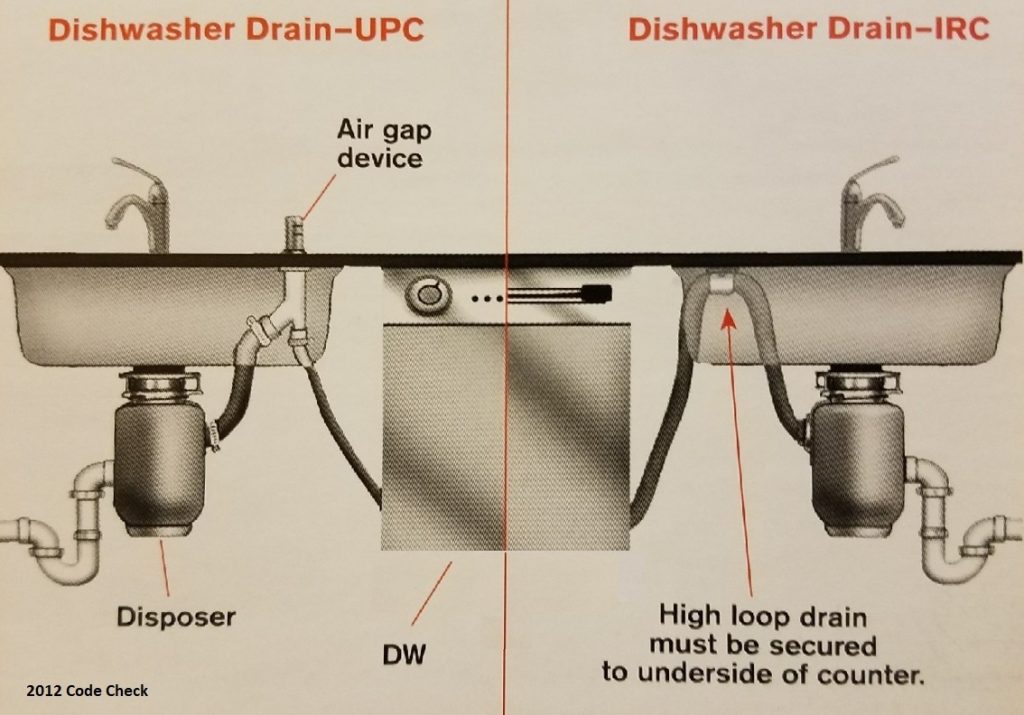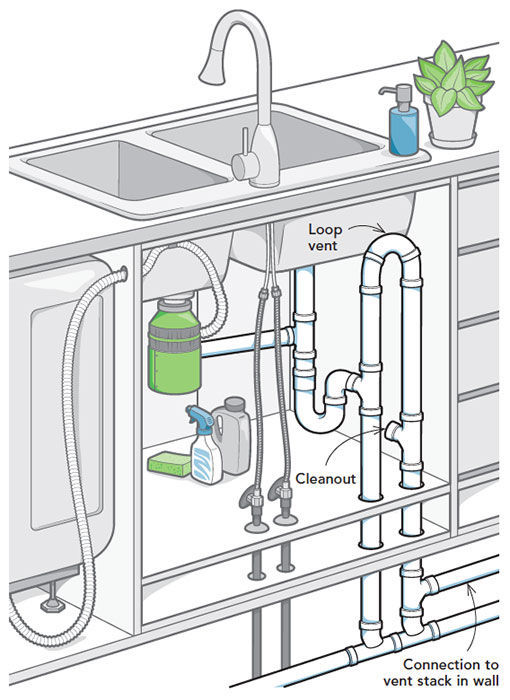What is an Air Gap in a Kitchen Sink?
An air gap in a kitchen sink is a device that is installed on the sink or countertop to prevent dirty water from backing up into the clean water supply. It is a simple yet effective solution that helps to keep your drinking water safe from contamination.
Traditionally, air gaps were only found in commercial kitchens, but nowadays they are becoming a standard feature in residential kitchens as well. In this article, we will discuss everything you need to know about air gaps in kitchen sinks, including their installation, benefits, and maintenance.
How to Install an Air Gap in a Kitchen Sink
If you are building a new kitchen or replacing your sink, make sure to install an air gap as per the plumbing code requirements in your area. You can either opt for a countertop air gap or a sink air gap, depending on your preference and kitchen design.
The installation process is relatively simple and can be done by a professional plumber or as a DIY project. The air gap usually consists of three main parts - the cap, the body, and the hose. The cap is attached to the top of the body, while the hose is connected to the bottom. The hose is then attached to the drain pipe, and the body is secured to the countertop or sink.
Why Do I Need an Air Gap in My Kitchen Sink?
The primary purpose of an air gap in a kitchen sink is to prevent contaminated water from entering the clean water supply. Without an air gap, there is a risk of dirty water from the sink backing up into the dishwasher and contaminating your dishes. This can happen due to a clogged drain or a malfunctioning garbage disposal.
An air gap acts as a physical barrier between the sink and dishwasher, ensuring that any contaminated water is drained out through the air gap instead of flowing back into the dishwasher or clean water supply.
How to Clean an Air Gap in a Kitchen Sink
Regular maintenance and cleaning of your air gap are essential to ensure its proper functioning. Over time, debris, food particles, and other contaminants can accumulate inside the air gap, causing clogs and potential leaks. Cleaning the air gap is a simple process that can be done using household items.
You will need a small brush, such as a toothbrush, and a mixture of water and vinegar. First, remove the cap from the air gap and use the brush to remove any visible debris. Then, pour the water and vinegar mixture into the air gap and let it sit for a few minutes. Use the brush to scrub the inside of the air gap, and then rinse it thoroughly with water. Finally, reattach the cap, and your air gap will be clean and ready to use.
Air Gap vs. High Loop in Kitchen Sink
Another method for preventing contaminated water from entering the clean water supply is by using a high loop. A high loop is created by looping the drain hose of the dishwasher up and attaching it to the underside of the countertop before connecting it to the drain pipe. This creates a barrier that prevents dirty water from flowing back into the dishwasher.
While a high loop is a viable alternative to an air gap, it is not as effective. An air gap provides a physical barrier between the sink and dishwasher, while a high loop only relies on gravity to prevent backflow. Additionally, a high loop may not be code-compliant in some areas, so it is best to check with your local plumbing authority before opting for this method.
How to Fix an Air Gap Leak in a Kitchen Sink
If you notice that your air gap is leaking, it is important to address the issue as soon as possible. Leaks can be caused by a variety of factors, such as a loose hose, a damaged cap, or a clog in the air gap itself. First, check for any loose connections and tighten them if necessary. If the leak persists, you may need to replace the cap or hose. In some cases, there may be a clog in the air gap, which can be removed by following the cleaning process mentioned earlier.
Air Gap Installation Requirements for Kitchen Sinks
The installation requirements for an air gap in a kitchen sink may vary depending on your location. It is essential to consult with a professional plumber or check with your local plumbing authority to ensure that your air gap is installed correctly and meets all code requirements.
Some common installation requirements include the height of the air gap above the sink, the size of the air gap, and the distance between the air gap and the dishwasher. By following these requirements, you can ensure that your air gap functions properly and keeps your drinking water safe.
How to Replace an Air Gap in a Kitchen Sink
Over time, your air gap may become damaged or worn out, and it will need to be replaced. The replacement process is similar to the installation process, but you will need to remove the old air gap first. Start by unscrewing the cap and removing the hose from the drain pipe. Then, unscrew the body of the air gap from the countertop or sink. You can now install the new air gap by following the steps mentioned earlier.
Air Gap Code Requirements for Kitchen Sinks
As mentioned earlier, the installation requirements for air gaps in kitchen sinks may vary depending on your location. In some areas, air gaps may be required by law, while in others, they may be optional. It is crucial to check with your local plumbing authority to ensure that your air gap meets all code requirements.
The main purpose of air gap code requirements is to ensure that your drinking water is safe from contamination. By following these requirements, you can be confident that your air gap is installed correctly and functioning properly.
How to Unclog an Air Gap in a Kitchen Sink
If you notice that your sink is draining slowly or that there is standing water in the sink after running the dishwasher, it may be a sign of a clogged air gap. A clog can occur due to food particles, grease, or other debris accumulating inside the air gap. Thankfully, unclogging an air gap is a simple process that can be done using a plunger or a small brush.
If using a plunger, cover the air gap with the rubber end, and gently plunge a few times to loosen the clog. If using a brush, follow the cleaning process mentioned earlier, but instead of using the vinegar and water mixture, use a drain cleaner specifically designed for kitchen sinks. After unclogging the air gap, run the hot water to flush out any remaining debris.
In conclusion, an air gap in a kitchen sink is an essential component that helps to keep your drinking water safe from contamination. By understanding its purpose, installation requirements, and maintenance, you can ensure that your air gap functions properly and provides you with clean and safe water for years to come.
The Importance of an Airgap in Your Kitchen Sink

What is an Airgap?
 An airgap
is a crucial component in a kitchen sink that helps to prevent contaminated water from entering your clean water supply. It is an empty space between the spout of your faucet and the flood level rim of your sink. This gap allows air to flow into the drain and break the siphon effect, preventing backflow of dirty water into your sink.
An airgap
is a crucial component in a kitchen sink that helps to prevent contaminated water from entering your clean water supply. It is an empty space between the spout of your faucet and the flood level rim of your sink. This gap allows air to flow into the drain and break the siphon effect, preventing backflow of dirty water into your sink.
Why is it Important?
 An airgap
is an essential feature in kitchen sinks to ensure the safety and cleanliness of your household's water supply. Without an airgap, there is a risk of contaminated water flowing back into your sink, potentially exposing you and your family to harmful bacteria and other contaminants.
An airgap
is an essential feature in kitchen sinks to ensure the safety and cleanliness of your household's water supply. Without an airgap, there is a risk of contaminated water flowing back into your sink, potentially exposing you and your family to harmful bacteria and other contaminants.
How Does it Work?
 The airgap
works by creating a physical barrier between the clean water supply and the drain. When the water flows through the faucet, it creates a negative pressure in the drain pipe, which can cause the water to siphon back into the sink. However, with
an airgap
, the air is allowed to flow into the drain, breaking the siphon effect and preventing any backflow.
The airgap
works by creating a physical barrier between the clean water supply and the drain. When the water flows through the faucet, it creates a negative pressure in the drain pipe, which can cause the water to siphon back into the sink. However, with
an airgap
, the air is allowed to flow into the drain, breaking the siphon effect and preventing any backflow.
Other Benefits of an Airgap
 Aside from preventing backflow,
an airgap
also helps to reduce the risk of clogs and blockages in your sink. The open space allows for better drainage and prevents debris from getting stuck in the pipes, which can lead to unpleasant odors and potential plumbing issues.
Aside from preventing backflow,
an airgap
also helps to reduce the risk of clogs and blockages in your sink. The open space allows for better drainage and prevents debris from getting stuck in the pipes, which can lead to unpleasant odors and potential plumbing issues.
Ensuring Proper Installation
 It is essential to have
an airgap
installed correctly in your kitchen sink for it to function effectively. Improper installation can lead to leaks and potential contamination of your water supply. It is recommended to have a professional plumber install
an airgap
to ensure it is done correctly and meets all necessary building codes and regulations.
In conclusion,
an airgap
is a vital feature in any kitchen sink and should not be overlooked during the design process. It not only helps to maintain the cleanliness and safety of your household's water supply but also prevents potential plumbing issues. Make sure to have
an airgap
installed in your kitchen sink for peace of mind and a hygienic home.
It is essential to have
an airgap
installed correctly in your kitchen sink for it to function effectively. Improper installation can lead to leaks and potential contamination of your water supply. It is recommended to have a professional plumber install
an airgap
to ensure it is done correctly and meets all necessary building codes and regulations.
In conclusion,
an airgap
is a vital feature in any kitchen sink and should not be overlooked during the design process. It not only helps to maintain the cleanliness and safety of your household's water supply but also prevents potential plumbing issues. Make sure to have
an airgap
installed in your kitchen sink for peace of mind and a hygienic home.












































































